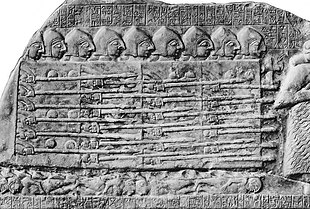
The phalanx (pl.: phalanxes or phalanges)[1] was a rectangular mass military formation, usually composed entirely of heavy infantry armed with spears, pikes, sarissas, or similar polearms tightly packed together. The term is particularly used to describe the use of this formation in ancient Greek warfare, although the ancient Greek writers used it to also describe any massed infantry formation, regardless of its equipment. Arrian uses the term in his Array against the Alans when he refers to his legions. In Greek texts, the phalanx may be deployed for battle, on the march, or even camped, thus describing the mass of infantry or cavalry that would deploy in line during battle. They marched forward as one entity.
The term itself, as used today, does not refer to a distinctive military unit or division (e.g., the Roman legion or the contemporary Western-type battalion), but to the type of formation of an army's troops. Therefore, this term does not indicate a standard combat strength or composition but includes the total number of infantry, which is deployed in a single formation known as a "phalanx".
Many spear-armed troops historically fought in what might be termed phalanx-like formations. This article focuses on the use of the military phalanx formation in Ancient Greece, the Hellenistic world, and other ancient states heavily influenced by Greek civilization.
- ^ (Ancient Greek: φάλαγξ; plural φάλαγγες, phalanges)